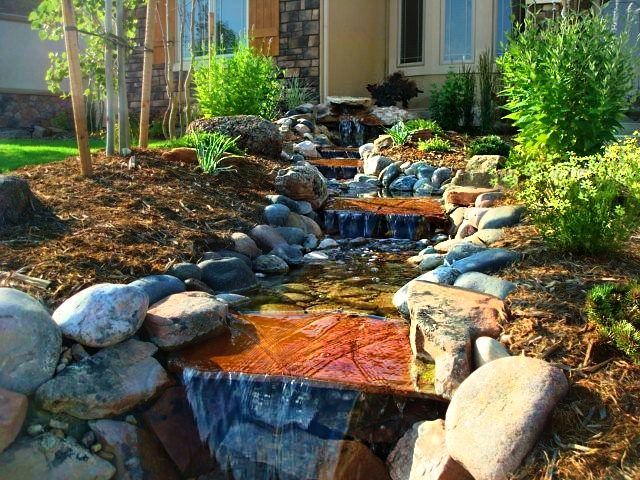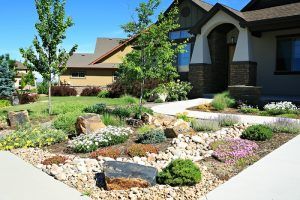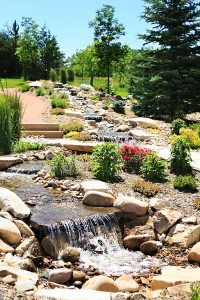Northern Colorado has a stunning variety of native trees, shrubs and flowering plants that create stunning results when they are used in any kind of landscaping project. There are more than 500 Fort Collins natives, and most are readily available for landscaping projects.
COLORADO'S TOP RATED LOCAL®
CUSTOM LANDSCAPE PROFESSIONALS

Landscaping with Colorado Native Plants
Benefits of Native Plants
It’s the way to go if you are concerned about water use, providing a habitat for local wildlife, avoiding the introduction of invasive plant species or even about saving money on your project.
Any plants that have evolved, over hundreds of years, to thrive in a geographic area are well-adapted to the soil and climate. They help promote the populations of beneficial, native insects that can help eliminate the need to use chemicals to keep gardens healthy and thriving.
Here are some great plants to choose from:
The bright orange berries of American Bittersweet (Celastrus scandens) are just about irresistible to more than a dozen species of birds. It is a large bush that provides really good shelter as well. Be sure to make sure you’ve got male and female plants or you won’t get any berries!
Colorado Natives
Trees and Shrubs
- Blue Spruce (Picea pungens)—The blue-green needles make these a Colorado-favorite. Their look is unique among the evergreens. They get big, up to around 120 feet. So, if you are planning to let them grow, make sure you’ve got the space.
- Piñon Pine (Pinus edulis)—The small squished-looking cones are a unique feature of these evergreens. Their needles are bright green. These evergreens grow well on dry, rocky soil and will generally grow to 20-to-50 feet tall.
- Rocky Mountain maple (Acer glabrum)—These shade-loving trees may be kept small, trimmed to behave as bushes. They grow red buds and provide beautiful yellow fall foliage.
- Serviceberry (Amelanchier alnifolia)—We love these for attracting wildlife with their blue berries, they also provide a range of bright red and orange fall colors.
- American plum, wild plum (Prunus americana)—If you are a pro at preserves, this is the plant for you. The fruit makes fantastic jam. These small trees are also extremely drought tolerant.
- Golden currant (Ribes aureum)—This spring bloomer has golden flowers and a lovely fragrance. The edible tart fruits make great preserves.
- Kinnikinnick (Arctostaphylos uva-ursi)—This evergreen forms a beautiful green groundcover and produces pink flowers and red berries that are favorites of birds and other critters. Make sure they’re in an area where they’ll get some shade part of the day.
- Antelope bitterbrush (Purshia tridentata)—This shrub blooms with small yellow flowers in early summer. It spreads out to provide much needed cover for small mammals. It does well in dry environments, so plant it in areas with other drought-resistant natives.
Flowering Plants
Native herbaceous perennials are a great choice to add color to your garden all spring and summer. They are very low maintenance and attract a lot of pollinating birds and insects. Here are a few of our favorites:
- Prairie zinnias (Zinnia grandiflora)—Great for groundcover, they grow about four inches tall and about 20 feet wide. They bloom in the late summer and early fall.
- Desert four o’clock (Mirabilis multiflora)—About one-to-three feet tall, it gets its name because of its late-afternoon blooming.
- Bee balm (Monarda fistulosa)—It’ll be tough to find anything better for attracting bees that will help pollinate your garden. Their pretty pink to purple flowers begin blooming mid summer.
- Harebells (Campanula rotundifolia)—these delicate blue bell-shaped flowers will thrive in places that other plants won’t. Try planting them in rocky or sandy areas.
- Rocky Mountain penstemon (Penstemon strictus)—Evergreen foliage makes this a great choice to use in multiple places throughout the garden. Long spikes of beautiful blue flowers, these plants live a long time and are very forgiving. If you don’t have the greenest thumb in the front range, they can help make you feel like a successful gardener.
- Blanket flowers (Gaillardia aristata)—For continuous blooming all summer long, you can’t do any better. They’ll keep your vases filled all season and provide a splash of color anywhere you want it in your garden.
Keep in Mind
Know your environment and your plants. The needs of native plants may be much different than those already in your garden. While regular fertilization and frequent watering may be the norm now, native plants often have much different requirements. Fertilizing and over-watering may damage them, attract unwanted pests, and promote the growth of damaging fungus and microorganisms.
Wildflower meadows occur in all areas of Colorado. Recreating a meadow native to Fort Collins or Loveland is a great way to get started. With the right mix of grasses, flowering plants and ground cover, you’ll end up with a beautiful and virtually zero maintenance garden.
We hope you’ve enjoyed this glimpse into the world of Colorado’s native plants and trees.
Give us a call, we’d love to help you design the perfect native plant garden for your Northern Colorado home.

Expert Designs
Showcase Landscape is locally owned and operated. We service Loveland, Fort Collins and surrounding areas.

Professional Services
Showcase Landscaping specializes in developing high quality and sustainable landscape design plans.
Speedy Service
Your Loveland landscaping and irrigation specialists. We are experts in everything from landscape design and more.
What Our Clients Think
Learn more about why Showcase Landscaping is a preferred landscaping company in Loveland!
Portfolio
Take a look at some of the projects we have completed, from landscaping to patio work and more.
Get Started
Ready for us to help with your landscaping project? Give us a call and get started today!





